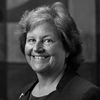I've always loved flying. For me, it's the ultimate combination of engineering and imagination, and it has allowed us to make the world a much smaller place, giving us easy access to new sights and experiences. Throughout history, women have had a key role to play in this industry, and it is in great part thanks to them that I've enjoyed such a fascinating career in aeronautics.
Many people will be unaware of the female pilots of World War II's Air Transport Auxiliary (ATA), but they have been a source of inspiration for me for many years. This civilian organisation consisted of pilots who ferried (often unfamiliar) warplanes between factories, maintenance units and front-line squadrons, playing a vital role in the war. A day's work for these pilots could involve several flights in several different types of plane, so their skills have been legendary in Britain ever since.

Dame Ann Dowling with the concept design for the silent aircraft initiative. Credit: Royal Academy of Engineering
One of these pilots in particular has always drawn my respect - Amy Johnson. Born in Yorkshire at the start of the 20th Century, she was the very first British-trained woman ground engineer, and displayed an innate skill in understanding the workings of anything mechanical. The desire to understand how things work is one that never leaves engineers and scientists, and Johnson definitely fitted that mould. She also retained an all-consuming determination to prove that female pilots could be just as competent as men, in an era when a woman's career often depended on her marital status. Johnson was president of the Women's Engineering Society from 1935-37. She was, in every sense of the word, a trailblazer.
Johnson's flying career before the war included some remarkable missions, including flying solo to Australia (a journey of 11,000 miles) in a second-hand plane and setting an England to Japan record with fellow pilot Jack Humphreys. I had a private pilot's licence for a number of years, so I have some small idea of the challenges Johnson would have faced on these missions. Her achievements still astound me, almost 75 years after her untimely death in a tragic flying accident over the Thames estuary.
Women like Johnson and her contemporaries across the world have certainly helped to shape my career. I started off as a mathematician but, having always looked to the skies, I was delighted to spend a summer at the Royal Aircraft Establishment at Farnborough. It was there that I discovered my particular interest in aircraft noise. I went on to read for a PhD in this subject at the University of Cambridge. My work focused on reducing the noise that Concorde's engines - designed to fly at over 1,300 mph (2,179 km/h) - made at take-off and landing. One of my greatest thrills was to cross the Atlantic supersonically on this iconic aircraft. Since then, I've been involved in incredible aeronautics projects all over the world, including one with MIT, Boeing, Rolls-Royce and NASA on the design of a 'silent' aircraft.
My research on efficient low-noise vehicles, particularly aircraft, continues, but these days much of my effort is spent on promoting engineering. In 2014, I became President of the Royal Academy of Engineering; I am the first woman to hold the post in its history. Being elected was a great honour, especially at a time when there is a growing recognition of the vital importance of engineering to society. But our task is far from complete. We are facing a shortage of people in all sectors of engineering, which poses a serious challenge to the profession.
If engineering businesses are to maintain and grow their vital contribution to society and the economy, we must do all we can to inspire a broad range of people to consider the rewards a career in engineering can offer. Particularly, we must engage greater numbers of women to pursue engineering careers if we are to secure the number of engineers we need in the future.
So, this International Women's Day (8 March 2015) I'd like to appeal, in particular, to young women considering their career options. Engineering is a wonderful, collaborative discipline that offers opportunities to travel the world and work with phenomenal individuals and organisations. If you see yourself as a creative person and think that engineering is not for you, I urge you to look again.
